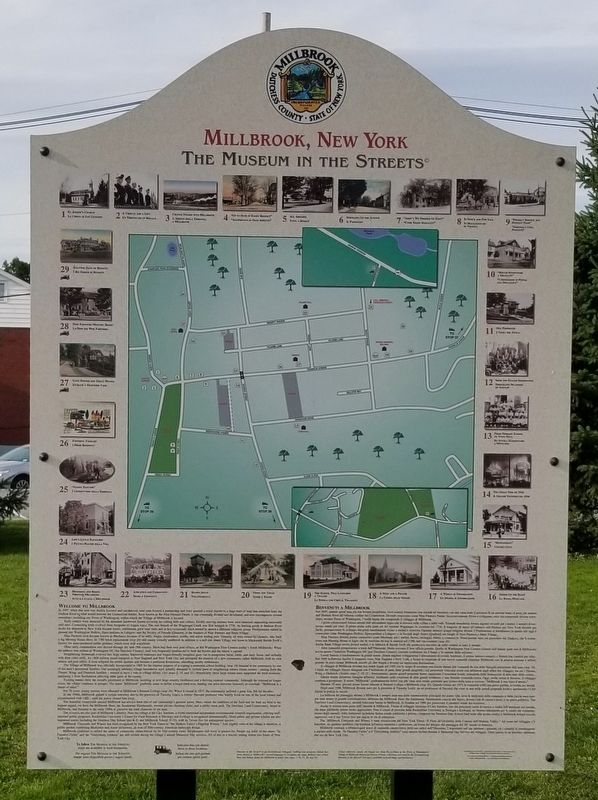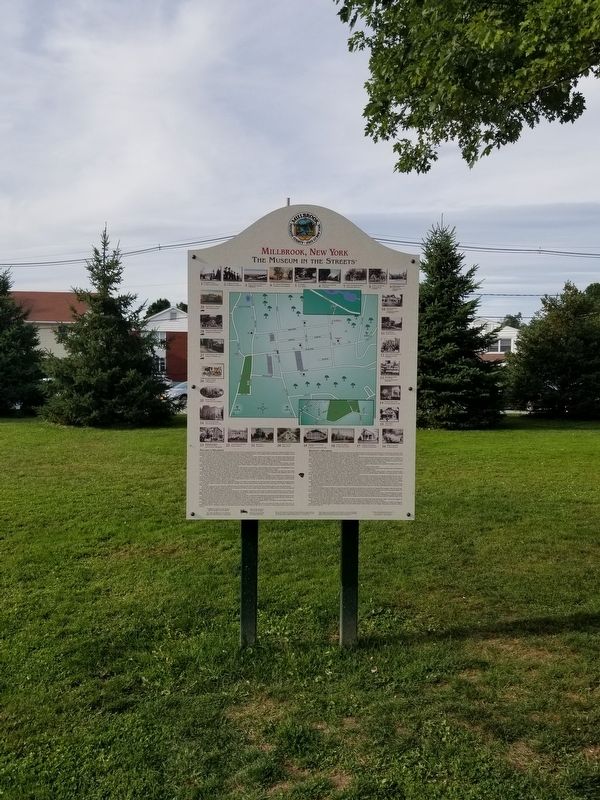Millbrook in Dutchess County, New York — The American Northeast (Mid-Atlantic)
Millbrook, New York
The Museum in the Streets
Inscription.
Welcome to Millbrook
In 1697, when this area was thickly forested and unexplored, nine men formed a partnership and were granted a royal charter to a huge tract of land that stretched from the Hudson River to what would become the Connecticut border. Soon known as the Nine Partners Patent, it was eventually divided and developed, and now encompasses several townships, including our Town of Washington, within which the Village of Millbrook is located.
Early settlers were attracted by the abundant hardwood forests covering the rolling hills and valleys. Swiftly moving streams were soon dammed, supporting successful mill sites. Connecting trails evolved from footpaths to wagon ways. The east branch of the Wappinger Creek was first bridged in 1736. As hauling goods to Hudson River docks for shipment to New York became easier, settlements grew near mills and at key crossroads. Each tended to attract a different religious group: Presbyterians settled in present-day Washington Hollow; Episcopalians in Lithgow; and the Society of Friends (Quakers) in the hamlets of Nine Partners and Harts Village.
Nine Partners soon became known as Mechanic because of its mills, forges, clockmaker, smiths, and active trading post. Virtually all were owned by Quakers, who built a log Meeting House there. its 1780 brick replacement (stop 28) still stands virtually unaltered. In addition to a mill site, Harts Village was home to blacksmith Beriah Swift’s factory for mass-produced coffee grinders, which were sold worldwide.
Other early communities also thrived through the mid-19th century. Most had their own post offices, as did Washington Four Corners (today's South Millbrook). When the address was written as Washington DC (for Dutchess County), mail was frequently misdirected to both the hamlet and the nation's capital!
Neighboring farmsteads evolved into large estates. Improved roadways and wagon-friendly turnpikes gave rise to prosperous horse, cattle, and dairy farms, and orchards with their cider mills. An 1869 railway eased transport to New England and New York City and prompted the creation of a new community called Millbrook, with its own station and post office. It soon eclipsed the earlier hamlets and became a preferred destination, absorbing nearby settlements.
The Village of Millbrook was officially incorporated in 1895 for the express purpose of accepting a memorial school building (stop 19) donated to the community by one the area's prominent families.
Our seemingly arbitrary village boundaries were actually designed to include parts of neighboring estates whose owners — among them the Thorne, Wing, and Dieterich families — wanted to have a vote in village affairs. (See stops 2, 18, and 27.) Historically, these large estates have supported the local economy, insulating it from fluctuations affecting other parts of the county.
Existing estates drew the socially prominent to Millbrook, resulting in new large country residences and a thriving summer community. Although the railroad no longer exists, the village continues to prosper. The name "Millbrook" gradually came to define a larger rural area, leading one town historian famously to conclude: "Millbrook is a frame of mind.”
For 70 years, young women were educated at Millbrook's Bennett College (stop 29). When it closed in 1977, the community suffered a great loss, felt for decades.
In the 1960s, Millbrook gained a certain notoriety due to the presence of Timothy Leary, a former Harvard professor who briefly lived on one of the local estates and experimented with LSD — until the police chased him away.
The beautiful countryside around Millbrook has always been one of our community's greatest assets. Here, where the traditions of the field and the hunt are held in the highest regard, we have the Millbrook Hunt, the Sandanona Harehounds, several private shooting clubs, and a public town park. The Dutchess Land Conservancy, based in Millbrook, was founded in the early 1980s to preserve the rural character of our area.
The sciences are also part of Millbrook's identity. Near the village is the Cary Institute, a world-renowned independent environmental research organization, offering well-attended public programs. Rockefeller University's Center for Field Research in Ethology and Ecology is recognized internationally. Good public and private schools are also important assets, including the Dutchess Day School (pre-K-8) and Millbrook School (9-12), with its Trevor Zoo for endangered species.
Millbrook Vineyards and Winery has been recognized by the New York Times as “the Hudson Valley's Flagship Winery.” And slightly west of the village is Innisfree, a public garden combining Modernist and Asian influences, an icon of 20th-century American landscape design.
Millbrook continues to reflect the sense of community characterized by its 19th-century roots. Shopkeepers still wave to passers-by. People say hello on the street. "In Flanders Fields" and the "Gettysburg Address" are still recited during the village's annual Memorial Day services. All of this in a bucolic setting within two hours of New York City.
Nel 1697, quando quest'area era una foresta inesplorata, nove uomini formarono una società ed ottennero con una carta reale il possesso di un enorme tratto di terra che andava dall 'Hudson River all'odierno confine del Connecticut. Diventò conosciuto come Nine Partners Patent. Successivamente diviso e sviluppato, esso ora comprende diverse townships, incluso Town of Washington, l'entità legale che comprende il villaggio di Millbrook.
I primi colonizzatori furono attratti dall'abbondante legno che si trovava sulle colline e nelle valli. Torrenti tumultuosi furono arginati ed usati per i mulini. I sentieri diventarono strade per carri. Il primo ponte sulla parte est del torrente Wappinger fu costruito nel 1736. Il trasporto di merci all'imbarco sull’Hudson per New York diventò piu facile, promuovendo lo sviluppo dei primi insediamenti vicino a mulini e crocevia. Ognuno attraeva gruppi religiosi diversi. I Presbiteriani si installarono in quello che oggi è conosciuto come Washington Hollow; Episcopaliani a Lithgow; e la Società degli Amici (Quakers) nei borghi di Nine Partners e Harts Viage.
Nine Partners divento presto conosciuto come Mechanic per i mulini, fucine, orologiai, fabbri, e commercio. Praticamente tutto era posseduto dai Quakers, che li costruirono una Meeting House in legno che fu sostituita da una in mattoni nel 1780, tutt'ora esistente (stop 28).
Anche Harts Village aveva diversi mulini, e la fabbrica di Beriah Swift che produceva macinini da caffe venduti in tutto il mondo.
Altre comunità prosperarono a metà dell'Ottocento. Molte avevano il loro ufficio postale. Quello di Washington Four Corners (situato nell'attuale parte sud di Millbrook) aveva spesso l'indirizzo Washington DC (per Dutchess County), creando confusione tra il borgo e Lawrence capitale della nazione!
Locali fattorie si trasformarono in grandi tenute. Strade migliori svilupparono l’allevamento di cavalli, bestiame, il settore lattiero-caseario, e frutteti con i mulini per sidro Nel 1869 la ferrovia facilitò il trasporto verso New England e New York, e favorì la creazione di una nuova comunità chiamata Millbrook, con la propria stazione e ufficio postale. In poco tempo Millbrook assorbì gli altri borghi e diventò un'apprezzata destinazione.
Il villaggio di Millbrook divenneuna entità legale nel 1895 con lo scopo di accettare una scuola donata alla comunità da una delle famiglie prominenti dell'area (stop 19).
I limiti del villaggio furono disegnati con l'inclusione di parte delle grandi proprietà i cui possessori volevano avere una influenza sugli affari del villaggio, tra cui i Thorne Wing, e Dieterich. (Vedere stops 2, 18, 27.) Storicamente, queste grandi proprietà hanno supportato l'economia locale, isolandola dalle fluttuazioni di altre aree della contea.
Queste tenute attirarono famiglie affluenti, risultando nella creazione di altre grandi residenze, e una fiorente comunità estiva. Oggi, anche senza la ferrovia, il villaggio continua a prosperare. Il nome "Millbrook" graduatamente definì una più vasta area rurale, portando uno storico della zona a scrivere: "Millbrook è uno stato d'animo.”
Durante 70 anni, giovani donne furono educate al Bennett College a Millbrook (stop 29). Quando chiuse nel 1977, la comunità soffi una grave perdita, avvertita per decadi.
Negli anni 1960, Millbrook diventò noto per la presenza di Timothy Leary, un ex-professore di Harvard che visse in una delle grandi proprietà locali e sperimentò I'LSD finchè la polizia lo cacciò.
La bellezza del attorno a Millbrook è sempre stata una delle caratteristiche principali del posto. Qui, dove le tradizioni della campagna e della caccia sono sempre state tenute in grande considerazione, abbiamo the Millbrook Hunt, the Sandanona Harehounds (caccia alla lepre), diversi club di caccia e sport, e un parco pubblico. The Dutchess Land Conservancy, società fiduciaria basata in Millbrook, fu fondata nel 1980 per preservare il carattere rurale del territorio.
Anche le scienze sono parte dell' identità di Millbrook. Vicino al villaggio troviamo il Cary Institute, uno dei principali centri di ricerca e studio dell’ambiente nel mondo, che tiene pubbliche letture molto apprezziate. Pure il centro di ricerche della Rockefeller University in Etologia e Ecologia, un famoso laboratorio per lo studio del comportamento degli animali. Altre istituzioni includono buone scuole pubbliche e private, comprese the Dutchess Day School (dall'asilo alla scuola media) e Millbrook School (scuola superiore) con il suo Trevor Zoo per specie in via di estinzione.
The Millbrook Vineyards and Winery è stata riconosciuta dal New York Times "Il Fiore all'Occhiello delle Cantine dell'Hudson Valley." Ad ovest del villaggio c'è Innisfree, un giardino pubblico che combina influenze asiatiche e moderniste, un'icona del disegno del paesaggio del 20° secolo in America.
Millbrook continua a riflettere quel senso di comunità caratteristico delle sue radici dell'Ottocento. I negozianti tutt'ora salutano i passanti, ed i cittadini si intrattengono a parlare nelle strade. "In Flanders Fields" e il "Gettysburg Address" sono ancora recitati durante il Memorial Day Service del villaggio. Tutto questo in un bucolico ambiente due ore da New York City.
Erected 2014 by The Museum in the Streets®. (Marker Number Map.)
Topics and series. This historical marker is listed in this topic list: Settlements & Settlers. In addition, it is included in the Quakerism, and the The Museum in the Streets®: Millbrook, New York series lists. A significant historical year for this entry is 1697.
Location. 41° 47.109′ N, 73° 41.755′ W. Marker is in Millbrook, New York, in Dutchess County. Marker is at the intersection of Franklin Avenue and Front Street, on the left when traveling east on Franklin Avenue. Touch for map. Marker is in this post office area: Millbrook NY 12545, United States of America. Touch for directions.
Other nearby markers. At least 8 other markers are within walking distance of this marker. Millbrook Bicentennial (a few steps from this marker); A Tribute and a Gift / Un tributo ed Un Regalo (within shouting distance of this marker); Tribute Garden (within shouting distance of this marker); "Aren’t We Dressed Up Fine?" / "Come Siamo Eleganti!" (within shouting distance of this marker); Millbrook Veterans Monument (within shouting distance of this marker); In Stock and For Sale / In Magazzino ed in Vendita (within shouting distance of this marker); Life's Little Pleasures / I Piccoli Piaceri della Vita (about 300 feet away, measured in a direct line); "Perfect Service and Perfect Food" / "Servizio e Cibo Perfetti" (about 300 feet away). Touch for a list and map of all markers in Millbrook.
Also see . . . Village of Milbrook. (Submitted on September 20, 2019, by Michael Herrick of Southbury, Connecticut.)
Credits. This page was last revised on November 30, 2021. It was originally submitted on September 20, 2019, by Michael Herrick of Southbury, Connecticut. This page has been viewed 286 times since then and 28 times this year. Photos: 1, 2. submitted on September 20, 2019, by Michael Herrick of Southbury, Connecticut.

